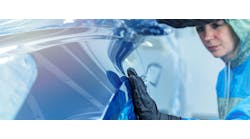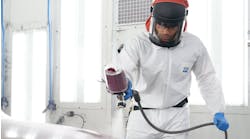Painting more vehicles with greater efficiency while using fewer materials remains a proven method to enhance efficiency for fleet managers and commercial repair shops. However, finding the right improvements to optimize the painting process can be challenging. A paint line study can help.
A paint line study marks an increasingly popular option for paint operations looking to increase their bottom line. This study examines equipment, materials, and methodologies used in painting to identify improvements that can help increase productivity, quality and profitability. To understand the advantages of a paint line study, explore the most frequently asked questions about their impact on the painting process.
What's the most common reason for a paint operation to undergo a line study?
Whether a shop aims to streamline prep and painting processes, reduce product and material consumption, enhance work quality or do all the above, the primary goal of improved operations remains. Improvement typically results in greater productivity and profitability. One example is a former sewer sucker truck company that saved money per unit by changing out its primer. Initially, they were painting everything on a pallet instead of racking it, handling about 15 units per month. Their production has now increased to up to 28 trucks per month. This change helped their business grow.
Most shops self-evaluate to improve. What's the advantage of involving a commercial coatings partner?
Paint crews and managers often become so engrossed in their routine processes that they miss potential problems. They might identify symptoms like production bottlenecks but lack the insight to see underlying issues. A commercial coatings partner offers an essential outside perspective. A coatings partner's paint line study thoroughly examines the entire painting operation, which is crucial for evaluating paint processes, product usage and equipment to determine potential areas for improvement.
What are the first steps to a line study?
Experts first start with a survey completed by the paint operation. A coatings partner will ask a wide range of questions, including the following:
- Total vehicles or units produced annually
- Current paint system
- Customer concerns
- Hazardous air pollutants (HAPS) or volatile organic compounds (VOC) concerns
- Quality control measures
- Customer expectations
- Annual material cost
The study begins with a good idea of the key issues at hand, and then experts conduct a walkthrough of the paint operation with several of the facility's key personnel to identify areas for improvement. Depending on the type and size of the business, the personnel might include the plant manager, paint manager, head paint technician, quality manager, and warranty manager.
What are the more common areas of focus?
Comprehensive paint line studies can include the following:
- Analyze substrate and prep work down to the grit of sandpaper used.
- Evaluate the type of spray booth, including temperature, humidity control and airflow.
- Discuss fluid handling and coating supply methods.
- Examine application equipment, noting spray guns and application parameters like psi range and fluid delivery rate.
- Review the type of oven, including heat source, temperature set point and curing times.
When a paint operation undergoes a line study, how do they typically show improvement?
It depends on the individual operation and its challenges, but the two most common areas of improvement include process time and cost savings—both of which help increase profitability. For example, during a recent paint line study for an auto parts manufacturer, the coatings partner noticed that a particular component was touched 20 times by a forklift from start to finish. When the manufacturer multiplied this high "touch time" by 6,000 parts per day, it immediately saw how changing this process could significantly reduce process time and labor costs.
Another example involves a commercial fleet repair customer who needed help reducing costs. A paint line study identified inefficiencies in their prep work. Specifically, they were sanding their substrate, priming it and then sanding it again. Coatings experts recommended a more thorough initial sanding, eliminating the need for additional sanding. As a result, the customer experienced significant savings in labor and materials.
How does a paint line study improve the quality of work?
The same line study team that helps a repair shop streamline its processes and optimize product and material usage will also closely observe paint technicians to ensure they follow proper paint mixing guidelines and application techniques. This can help techs deliver a deep, beautiful, high-gloss finish on every job.
How are results provided to the paint operation?
After observing the painting process and evaluating data from time studies and savings initiatives, a coatings partner will present recommendations for improvement, often including digital modeling of the revised paint process.
Evaluating and optimizing paint processes remains essential for enhancing productivity, quality, and profitability in paint operations. A paint process line study by a coatings partner provides invaluable third-party insights and recommendations by examining equipment, materials and methodologies to identify areas for improvement. A coatings partner offers an outside perspective that can reveal underlying issues and effective solutions. With a detailed survey and thorough walkthrough, experts can pinpoint key issues and develop targeted recommendations, focusing on substrate analysis, spray booth evaluation, fluid handling, application equipment, and oven settings. Whether streamlining prep and painting processes, reducing material consumption or enhancing work quality, the goal is always improvement.





